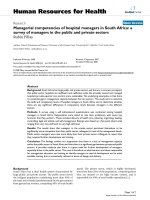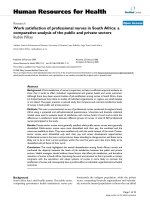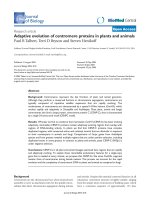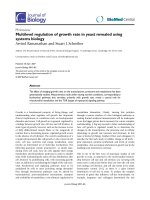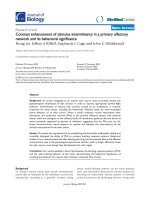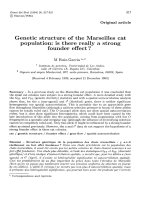Báo cáo sinh học: "Breeding structure of Drosophila buzzatii in relation to competition in prickly pears (Opuntia ficus-indica)" potx
Bạn đang xem bản rút gọn của tài liệu. Xem và tải ngay bản đầy đủ của tài liệu tại đây (915.15 KB, 16 trang )
Original
article
Breeding
structure
of
Drosophila
buzzatii
in
relation
to
competition
in
prickly
pears
(Opuntia
ficus-indica)
JE
Quezada-Díaz
H
Laayouni
A
Leibowitz,
M
Santos
A
Fontdevila
Departament
de
Genetica
i
de
Microbiologia,
Universitat
Autonoma
de
Barcelona,
08193
Bellaterra,
Barcelona,
Spain
(Received
15
October
1996;
accepted
22
April
1997)
Summary -
Rotting
Opuntia
ficus-indica
fruits
(prickly
pears)
are
used
as
breeding
sites
for
up
to
four
Drosophila
species
(D
melanogaster,
D
simulans,
D
buzzatii
and
D
hydei)
in
southern
Spain.
A
field
experiment
showed
that
the
larvae
of
D
buzzatii
are
resource
limited
in
Opuntia
fruits
available
for
oviposition
for
108
h.
Experimental
fruits
infested
with
D
larvae
were
divided
into
two
halves;
the
larvae
in
one
half
were
allowed
to
develop
normally,
while
those
in
the
other
half
were
provided
with
extra
food.
Approximately
five
times
as
many
D
buzzatii
emerged
from
the
supplemented
as
from
the
control
halves,
and
the
flies
emerging
from
the
supplemented
halves
were,
on
average,
larger
than
those
emerging
from
the
control
halves.
F-statistics
were
estimated
from
allozyme
data
for
the
D
buzzatii
flies.
The
values
obtained
from
the
supplemented
halves,
coupled
with
computer
simulations
to
compare
these
estimates
with
the
expected
values
generated
by
a
limited
number
of
mating
pairs
contributing
progeny
to
a
fruit,
suggest
an
effective
size
of
about
30
individuals.
Even
though
95%
bootstrap
confidence
intervals
for
F
IS
estimates
comparing
the
supplemented
and
control
halves
do
not
overlap,
computer
simulations
suggest
that
we
cannot
support
the
hypothesis
that
selection
is
acting
on
allozyme
variation.
body
size
/
cactophilic
Drosophila
/
competition
/
density-dependent
mortality
/
population
structure
Résumé -
Structure
génétique
des
populations
de
Drosophila
buzzatü
en
situation
de
compétition
dans
les
figues
de
barbarie
(Opuntia
ficus-indica).
Les
fruits
pourris
d’Opuntia
ficus-indica
(,figues
de
Barbarie)
sont
utilisés
comme
sites
de
reproduction
par
quatre
espèces
de
drosophiles
(D
melanogaster,
D
simulans,
D
buzzatii
et
D
hydei!
dans
le
sud
de
l ’Espa
9
ne.
Une
expérimentation
sur
le
terrain
a
montré
que
les
larves
de
D
buzzatii
ont
des
ressources
limitées
dans
les
fruits
d’Opuntia
disponibles
pour la
ponte
pendant
108
h.
Des
fruits
expérimentaux
infestés
de
larves
de
drosophiles
ont
été
divisés
en
deux
moitiés :
dans
la
première,
les
larves
ont
pu
se
développer
normalement
et,
dans
la
seconde,
*
Correspondence
and
reprints
on
a
ajouté
de
la
nourriture.
À
peu
près
cinq
fois
plus
de
D
buzzatii
sont
sorties
des
moitiés
complémentées
en
comparaison
aux
moitiés
de
référence,
et
les
mouches
sortant
des
moitiés
complémentées
ont
été
en
moyenne
plus
grandes
que
celles
sortant
des
moitiés
de
référence.
Des
statistiques
F
ont
été
estimées
à
partir
de
données
sur
allozymes
pour
les
mouches
D
buzzatii.
Les
valeurs
obtenues
à
partir
des
moitiés
supplémentées,
couplées
avec
des
simulations
sur
ordinateur
pour
comparer
ces
estimées
avec
les
valeurs
espérées
générées
par
un
nombre
limité
d’accouplements
contribuant
au
peuplement
d’un
fruit
suggèrent
un
effectif
ef,!’ccace
d’environ
30
individus.
Même
si
les
intervalles
de
confiance
de
FIg
donnés
par
la
méthode
de
bootstrap
pour
les
moitiés
supplémentées
et
de
référence
ne
se
recouvrent
pas,
les
simulations
ne
permettent
pas
d’appuyer
l’hypothèse
selon
laquelle
la
sélection
s’exerce
sur
la
variation
allozymique.
taille
/
drosophile
cactophile
/
compétition
/
mortalité
/
structure
de
population
INTRODUCTION
Populations
of
many
organisms,
particularly
insects,
are
subdivided
in
the
sense
that
females
lay
eggs
in
discrete
and
ephemeral
resources,
each used
as
a
breeding
site
by
a
small
number
of
individuals
(Heed,
1968;
Jaenike
and
Selander,
1979;
Shorrocks,
1982;
Brncic,
1983;
Lacy,
1983;
Hoffmann
et
al,
1984;
Santos
et
al,
1989;
Thomas
and
Barker,
1990;
Santos,
1997).
A
strong
motivation
to
study
the
effects
of
such
a
population
structure
relates
to
the
pervasive
idea that
environmental
heterogeneity -
arising
because
selection
proceeds
in
different
directions
in
different
places,
because
there
are
complementary
interactions
among
genotypes,
or
because
there
is
an
aggregated
distribution
of
eggs
over
patches -
can
maintain
genetic
heterogeneity
(Levene,
1953;
Hoffmann
and
Nielsen,
1985;
Hedrick,
1986;
Gillespie
and
Turelli,
1989;
Gillespie,
1991;
Dytham
and
Shorrocks,
1992,
1995).
A
basic
ingredient
in
most
genetic
models
is
the
existence
of
crowded
conditions
within
patches
(ie,
selection
is
’soft’,
meaning
that
density regulation
occurs
within
each
patch
separately).
If
competition
is
absent,
environmental
heterogeneity
might
be
irrelevant
to
explain
genetic
variation.
The
presence
of
competition
in
natural
populations
of
Drosophila
has
been
inferred
in
several
cases
(eg,
Fellows
and
Heed,
1972;
Atkinson,
1979;
Prout
and
Barker,
1989),
but
a
clear
experimental
demonstration
was
first
provided
by
Grimaldi
and
Jaenike
(1984).
These
authors
collected
mushrooms
infested
with
larvae
and
divided
each
mushroom
into
two;
the
larvae
in
one
half
were
allowed
to
develop
normally,
while
those
in
the
other
half
were
provided
with
extra
food
(see
also
Jaenike
and
James,
1991).
They
showed
that
there
is
density-
dependent
mortality
in
natural
populations,
and
that
flies
emerging
from
halves
of
supplemented
mushrooms
are
larger
than
flies
emerging
from
control
halves.
An
important
conclusion
to
be
obtained
from
this
experiment
is
that
in
natural
populations
of
Drosophila
there
is
the
opportunity
for
selection
(Crow,
1958;
Arnold
and
Wade,
1984).
From
an
evolutionary
perspective,
however,
the
important
point
is
not
to
show
that
there
is
opportunity
for
selection,
but
that
selection
does
indeed
differentially
affect
the
various
genotypes.
We
report
here
an
experiment
designed
to
investigate
the
incidence
of
compe-
tition
in
Opuntia
ficus-indica
fruits
(prickly
pears)
in
the
field,
together
with
an
analysis
of
genetic
diversity
for
the
Drosophila
buzzatii
(Patterson
and
Stone)
flies
that
emerged
from
natural
substrates.
Adults
of
this
species
have
been
reared
from
rotting
Opuntia
cladodes,
which
are
not
significantly
utilized
as
breeding
sites
by
other
drosophilids
in
the
Old
World
(at
least
during
the
summer
months,
Santos
et
al,
1988,
1992).
In
contrast
to
this,
the
Opuntia
fruits
can
be
exploited
by
other
Drosophila
species
in
southern
Spain.
These
fruits
are
sweet,
fleshy,
frequently
vis-
ited
by
Drosophila
adults
after
falling
from
the
plant,
and
very easy
to
manipulate
experimentally.
Although
they
are
individually
small
(from
approximately
30
to
90
g
of
wet
weight),
’en
masse’
they
can
form
habitats
of
considerable
size.
We
do
not
have
an
estimate
of
the
relative
contributions
of
Opuntia
fruits
and
cladodes
to
the
total
population
density
of
D
buzzatii,
but
during
the
fruit
season
(from
August
to
November
in
southern
Spain)
it
is
quite
likely
that
a
significant
proportion
of
D
buzzatii
flies
come
from
Opuntia
fruits.
We
investigated
the
allozyme
genotypes
of
D
buzzatii
emerging
from
the
fruits,
and
obtained
estimates
of
F-statistics.
Because
under
field
conditions
we
are
never
sure
of
what
fraction
of
the
genetic
differenti-
ation
is
attributable
to
drift
(founder
events
of
individual
patches)
or
to
selection,
the
flies
raised
from
halves
of
supplemented
fruits
(=
’non-limited
resource’,
see
below)
were
used
to
obtain
empirical
distributions
of
F-statistics
likely
to
be
due
to
drift.
Measures
of
inbreeding
were
then
used
to
estimate
the
effective
number
of
parents
contributing
gametes
to
each
fruit,
and
to
see
whether
or
not
there
is
genetic
differentiation
between
breeding
sites
as
a
result
of
selection.
Materials
and
methods
Description
of
collections
Samples
were
collected
in
September
1993
from
a
disused
Opuntia
fccus-indica
plantation
(Carboneras,
SE
Spain),
described
in
detail
elsewhere
(Ruiz
et
al,
1986).
At
that
time
of
the
year
there
are
abundant
Opuntia
fruits
which
are
exploited
by
D
melanogaster,
D
simulaus,
D
buzzatii,
and
D
hydei.
On
3
September,
300
undamaged
mature
fruits
were
harvested
from
the
Opuntia
stems,
labelled
with
coloured
bands,
and
placed
at
random
in
the
experimental
area
on
4
September
after
cutting
a
small
slice
at
the
top
to
allow
for
oviposition
by
Drosophila
females.
After
various
periods
of
time
in
the
field
these
fruits
were
recollected
and
placed
separately
in
jars
on
a
bed
of
sand,
covered
with
gauze.
After
24
h,
30
labelled
fruits
were
collected.
After
48
h,
another
30
fruits
were
collected
and
divided
in
half
longitudinally.
One
half
of
each
fruit
(’control’
half)
was
left
untreated
while
half
of
a
fresh,
uncolonized
fruit,
was
added
to
the
other
’supplemented’
(’=
non-limited
resource’)
half.
This
approximately
doubled
the
wet
mass
of
food
available
to
larvae.
The
same
procedure
was
followed
for
an
additional
sample
of
30
fruits
collected
after
72
h.
Finally,
on
9
September
we
randomly
collected
124
fruits
out
of
the
remaining
210
fruits
that
had
been
left
in
the
field
for
108
h.
Control
and
supplemented
halves
were
produced
for
63
of
those
fruits,
whereas
the
remaining
61
were
placed
into
separate
jars
without
cutting.
These
fruits
served
as
the
control
for
the
cutting
treatment.
The
experimental
fruits
were
kept
at
room
temperature
(22-27 °C)
in
the
makeshift
laboratory
near
the
field
site
and
checked
regularly
for
emergent
adults.
From
the
time
of
first
adult
emergence
(13
September),
all
jars
were
examined
daily
and
emerged
adults
were
fixed
in
a
3:1
mixture
of
alcohol
and
glycerol
except
D
buzzatii
flies,
which
were
kept
alive
in
vials
containing
5
mL
of
standard
cornmeal-
agar-yeast
food.
D
melanogaster
and
D
simulans
males
were
distinguished
by
the
differences
in
their
external
genitalia
(Sturtevant,
1919).
No
attempt
was
made
to
distinguish
between
females
of
these
two
species
and
their
numbers
were
grouped
together
into
a
single
class.
For
each
species
that
emerged
from
the
two
halves
of
the
63
fruits
that
remained
in
the
field
for
108
h,
the
wing
length
of
up
to
five
males
per
collection
was
measured
(see
Leibowitz
et
al,
1995).
Wing
length
was
used
as
an
index
of
adult
body
size
because
it
is
a
more
convenient
measure
when
flies
can
be
killed.
The
average
wing
length
from
each
control
and
supplemented
half
fruit
was
calculated
by
weighting
the
mean
of
each
collection
by
the
number
of
males
of
each
species
in
that
collection.
Allozyme
electrophoresis
From
most
of
the
108
h
Opuntia
fruits
that
yielded
D
buzzatii
flies,
a
random
sample
of
individuals
was
assayed
for
four
polymorphic
enzyme
loci
(Est-2,
Aldox,
Pept-2
and
Adh-1).
Details
of
the
electrophoretic
techniques,
allele
nomenclature
[standardized
following
Barker
and
Mulley
(1976),
and
Barker
et
al
(1986)],
chromosome
mapping,
and
gametic
associations
between
these
loci
and
between
them
and
the
polymorphic
inversions
in
the
population
of
Carboneras,
are
given
elsewhere
(Quezada-Diaz
et
al,
1992;
Quezada-Diaz,
1993;
Betran
et
al,
1994).
Briefly,
Est-2
segregates
for
five
alleles,
and
the
other
three
loci
segregate
for
two
alleles
each. Est-2
and
Aldo!
are
linked
to
the
inversions
on
the
second
chromosome,
while
Pept-2
is
outside
the
inverted
fragments.
There
are
strong
linkage
disequilibria
(sensu
Lewontin
and
Kojima,
1960)
between
alleles
of
Est-2
and
Aldo!
with
the
second
chromosome
arrangements.
Thus,
alleles
Est-2
a
and
Est-!b
are
segregating
within
the
gene
arrangements
2st
and
2j,
with
the
former
allele
at
higher
frequency
in
!st
and
the
latter
in
higher
frequency
in
2j.
Allele
Est-2°
+
is
fixed
in
the
gene
arrangement
2jq
7,
and
alleles
Est-2
C
and
Est-2
d
are
only
present
in
the
inversion
!jz3.
Allele
!o!o:E!
is
associated
with
2st.
Adh-1
is
located
on
the
third
chromosome
which
lacks
polymorphic
inversions
(Labrador
et
al,
1990).
Statistical
analyses
for
the
allozyme
data
Analyses
of
allelic
frequencies
and
the
calculation
of
F-statistics
using
the
methods
of
Weir
(1990)
were
accomplished
with
the
G
ENEP
OP
(v.
1.2)
population
genetics
software
(Raymond
and
Rousset,
1995).
Associations
among
alleles
at
two
loci
were
measured
by
the
composite
digenic
disequilibrium
coefficient
A
AB
(Weir
and
Cockerham,
1989;
Weir,
1990).
Alleles
other
than
Est-2
a
were
grouped
together
into
a
single
class.
This
coefficient
is
equal
to
zero
if
the
allelic
state
at
one
locus
is
not
correlated
with
that
at
another.
RESULTS
Evidence
of
competition
in
natural
substrates
A
total
of
34
745
individuals
of
the
four
Drosophila
species
emerged
from
the
exper-
imental
fruits
of
Opuntia
,ficus-indica
(39.6%
D
melanogaster,
54.4%
D
simulans,
4.3%
D
buzzatii
and
1.6%
D
hydei).
Table
I
shows
their
average
numbers
per
fruit,
together
with
Wilcoxon
matched-pair
signed-rank
tests
(Siegel
and
Castellan,
1988)
comparing
the
number
of
flies
in
each
half.
After
108
h
in
the
field,
approximately
five
times
as
many
D
buzzatii
emerged
from
the
supplemented
as
from
the
control
halves
(only
187
D
buzzatii
emerged
from
the
control
halves,
whereas
845
emerged
from
the
supplemented
halves).
A
potential
problem
with
’the
cutting
treatment’
might
be
that,
for
any
reason
(eg,
control
halves
dried-out
quicker),
a
lower
number
of
adult
flies
emerged
from
the
control
fruits.
A
comparison
of
the
average
number
of
males
and
females
(D
melanogaster/D
simulans
females
were
pooled)
of
Drosophila
species
that
emerged
from
the
108
h
whole
fruits
with
twice
as
many
emerging
from
the
108
h
control
halves
suggests
that
this
is
probably
not
the
case
here
(Wilcoxon-
Mann-Whitney
tests
ranged
from
z
=
0.03,
P
=
0.972;
for
D
melanogaster
males,
to
z
=
1.18,
P
=
0.236;
for
D
simulans
males).
Except
for
D
hydei,
the
Spearman
rank
correlations
between
the
emergence
numbers
were
positive
and
statistically
significant
for
all
pairs
of
species
in
the
108
h
supplemented
halves.
However,
in
both
the
108
h
control
halves
and
108
h
whole
fruits
the
D
buzzatii-D
melanogaster
and
D
buzzatii-D
simulans
rank
correlations
were
very
low
and
statistically
non-
significant,
probably
owing
to
the
increase
in
mortality
suffered
by
D
buzzatii.
The
only
differences
in
size
distributions
between
flies
emerging
from
the
108
h
control
and
supplemented
halves
were
found
for
D
buzzatii
(table
II).
Because
up
to
five
males
per
fruit
per
collection
were
measured
for
each
species
(see
Material
and
methods),
in
the
108
h
control
halves
we
had
an
index
of
body
size
for
most
of
the
D
buzzatii
males
that
emerged.
Therefore,
we
could
carry
out
a
multiple
regression
analysis
of
the
effect
of
each
species’
density
(estimated
as
the
number
of
males
that
emerged
in
a
given
fruit)
on
the
individual
wing
length
of
each
D
buzzatii
male.
Forward
stepwise
regression
coefficients
were
statistically
significant
for
D
buzzatii
(,8i
nt
ra
=
-0.018
P
=
0.008), D
simulans
(0i,,
ter
=
-0.004,
P
<
0.001)
and
D
melanogaster
(Winter
=
0.002,
P
=
0.006),
the
negative
regression
for
D
buzzatii
suggesting
that
intraspecific
competition
is
occurring
within
the
breeding
sites.
The
negative
correlation
between
the
wing
length
of
D
buzzatii
and
the
number
of
D
simulans
might
also
indicate
the
occurrence
of
interspecific
competition,
but
some
care
must
be
taken
with
such
an
interpretation
because
it
is
possible
that
conditions
that
enhance
the
numbers
of
D
simulans
may
adversely
affect
the
body
size
of
D
buzzatii.
Conversely,
some
conditions
may
enhance
the
numbers
of
D
melanogaster
and
the
body
size
of
D
buzzatii,
which
could
explain
the
highly
significant
positive
correlation
found
between
both
variables.
Figure
1
shows
the
number
of
male
flies
that
emerged
from
the
108
h
control
and
supplemented
fruits
through
time.
It
is
obvious
that
D
melanogaster
and
D
simulans
have
shorter
development
times
than
D
buzzatii
and
D
hydei,
which
clearly
suggests
that
they
would
always
be
at
a
competitive
advantage
at
high
larval
densities
(see
Discussion).
of population
structure
Table
III
presents
summary
F-statistics
for
the
D
buzzatii
flies
that
emerged
from
the
108
h
Opuntia
fruits
(the
raw
data
are
available
upon
request
to
the
corresponding
author).
For
selectively
neutral
loci,
the
extent
of
genetic
differentiation
of
the
subpopulations
in
the
present
situation,
where
there
is
only
one
round
of
drift
and
random
mating
in
the
population
at
large
(Quezada-Diaz
et
al,
1992;
Barbadilla
et
al,
1994),
is
characterized
by
N,,
the
effective
number
of
locally
breeding
adults
(Wade
and
McCauley,
1988).
All
confidence
intervals
for
F
values
in
the
108
h
supplemented
fruits
included
zero,
which
suggests
that
Ne
is
relatively
large
(see
below).
On
the
other
hand,
F
IS
and
F
ST
values
were
different
from
zero
in
the
108
h
control
fruits,
indicating
that
there
is
an
excess
of
heterozygotes
within,
and
a
substantial
differentiation
among,
limited
resource
fruits.
The
confidence
intervals
for
F
IS
do
not
overlap,
and
this
could
be
taken
as
a
real
difference
between
the
supplemented
and
the
control
fruits.
However,
some
caution
is
needed
with
this
interpretation
because
it
could
be
argued
that
with
four
loci
(as
here),
and
under
the
null
hypothesis
Ho
:
F
IS
=
0,
estimates
of
this
parameter
are
negative
for
all
loci
with
a
probability
of
(1/2)
4
=
0.0625,
and
zero
will
be
included
in
the
confidence
interval.
Raymond
and
Rousset
(1995b)
have
recently
stressed
that
bootstrap
resampling
to
build
a
confidence
interval
is
incorrect
when
the
number
of
loci
is
small.
Exact
tests
for
population
differentiation
(Raymond
and
Rousset,
1995a,
b)
com-
paring
control
and
supplemented
fruits
provided
no
evidence
for
allelic
heterogene-
ity
at
any
locus.
Analysis
of
two-locus
linkage
disequilibrium
coefficients
showed
only
eight
significant
disequilibria
out
of
179
possible
comparisons.
Four
of
these
pairs
have
both
members
located
on
the
second
chromosome,
and
the
other
four
involved
the
Adh-1
locus.
Thus,
no
clear
patterns
were
found,
and
this
result
could
be
taken
as
another
reflection
of
large
effective
population
size
within
Opuntia
fruits
(see
below).
of
the
number
of
parents
breeding
on
a
single
fruit
Given
that
flies
from
the
supplemented
halves
have
developed
in
’non-limited
resources’,
it
is
important
to
recall
that
the
corresponding
F-values
in
table
III
do
not
mix
drift
and
selection
but
probably
reflect
the
sampling
effect.
Therefore,
we
used
computer
simulations
to
compare
F-statistics
from
supplemented
fruits
with
the
expected
values
generated
by
various
numbers
of
mating
pairs
contributing
to
a
breeding
site.
The
main
steps
of
our
reasoning
for
disentangling
the
effects
of
drift
and
selection
are
summarized
in
figure
2.
Different
numbers
of
mating
pairs
were
selected
randomly
to
contribute
to
19
breeding
sites,
and
a
number
of
offspring
equal
to
that
obtained
for
the
supplemented
fruits
(between
5
and
80
individuals
per
fruit)
was
sampled
at
random
from
each
breeding
site.
Even
though
theoretical
predictions
about
the
expected
F-values
could
be
easily
made
from
the
above
assumptions
(see
below),
we
think
it
may
be
useful
to
have
an
idea
of
the
standard
deviations
of
their
distributions
in
this
particular
case
(ie,
equal
number
of
fruits
and
emerging
adults
than
in
the
actual
sample).
F-statistics
were
calculated
according
to
the
methods
of
Weir
(1990),
and
100
simulations
were
undertaken
for
each
set
of
conditions.
The
interactive
matrix
algebra
program
MATLAB
(V
4.0
for
Windows)
was
used
for
computations
on
a
486
(66
Mhz)
PC-compatible.
For
simplicity,
we
considered
four
biallelic
loci
(alleles
other
than
Est-2’
were
grouped
into
a
single
class)
with
allele
frequencies
in
the
total
population
equal
to
those
estimated
from
the
supplemented
halves.
Estimates
of
F-statistics
after
grouping
alleles
are
also
given
at
the
bottom
of
table
III.
Fs
T
and
F
IS
values
approach
zero
(fig
3)
as
more
mating
pairs
contribute
to
a
site,
and
comparisons
with
the
actual values
in
table
III
(ie,
those
from
the
supplemented
halves)
suggest
that
at
least
15
females
oviposit
on
a
site.
The
expected
values
of Fis
in
figure
3
could
also
be
approximated
by -1/(2
Ne
-
1)
(Kimura
and
Crow,
1963).
Thus,
for
five,
ten
and
15
mating
pairs
F
IS
approximates
to
-0.053,
-0.026
and
- 0.017,
respectively,
which
are
very
close
to
the
numerical
values.
The
simulations,
however,
assume
that
females
contribute
equally
to
the
total
number
of
eggs
of
each
fruit,
but
the
actual
estimate
is
for
an
effective
number
of
mating
pairs.
Let
us
accept
the
figure
of
15
mating
pairs
contributing
progeny
to
a
site.
It
would
be
possible,
then,
to
overcome
the
difficulties
with
the
bootstrap
method
and
build
a
confidence
interval
for
the
F
IS
value
in
the
control
fruits
under
the
hypothesis
that
selection
has
a
negligible
effect
on
the
allozyme
variation.
To
do
this,
we
generated
500
independent
samples
that
matched
the
situation
for
the
control
fruits,
ie,
the
mating
pairs
were
selected
randomly
to
contribute
to
12
breeding
sites,
and
a
number
of
individuals
equal
to
the
actual
sample
size
was
taken
at
random
per
site.
Figure
4
shows
the
distribution
of
the
F
IS
values
obtained.
We
find
that
the
probability
of
F
IS
being
less
than
or
equal
to
-0.0687
(ie,
the
actual
value
in
the
control
fruits)
is
0.162,
and
it
is
clear
that
we
cannot
support
the
hypothesis
of
a
heterozygote
excess
in
the
control
fruits
caused
by
selection
with
the
evidence
from
the
simulations.
DISCUSSION
We
have
shown
that
the
larvae
of
D
buzzatii
are
resource
limited
in
Op!ntia
fruits,
and
this
species
suffers
density-dependent
mortality
in
the
field
(table
I).
In
addition
to
larval
viability,
resource
limitation
also
has
a
significant
effect
on
body
size,
a
trait
phenotypically
positively
correlated
with
adult
fitness
components
(Santos
et
al,
1988,
1992;
Leibowitz
et
al,
1995).
The
relevance
of
resource
structure
for
expected
mating
success
and/or
fertility
of
the
fly
is
clearly
indicated
by
the
substantial
differences
found
in
the
individual
body
size
due
to
properties
of
the
breeding
sites
in
which
it
grew
as
a
larva
(Prout
and
Barker,
1989),
and
both
of
these
effects
can
be
interpreted
as
demonstrating
that there
is
a
large
opportunity
for
selection
under
natural
conditions.
The
same
conclusion
had
been
previously
reached
by
Grimaldi
and
Jaenike
(1984)
for
mushroom-feeding
Drosophila,
which
suggests
that
such
phenomena
have
to
be
considered
as
general
in
natural
conditions.
It
should
be
noted
that
the
fruits
in
our
experiment
were
only
available
for
oviposition
for
at
most
108
h.
If
oviposition
continues
beyond
this
time,
resource
limitation
in
undisturbed
Opuntia
fruits
may
actually
be
greater
than
our
data
suggest.
When
resources
are
scarce,
those
species
(or
individuals
within
a
species)
with
a
short
developmental
period
are
presumably
at
a
competitive
advantage
because
larvae
are
more
likely
to
complete
development
before
their
patch
is
exhausted
(Bakker,
1961,
1969;
Nunney,
1983;
Mueller,
1988;
Partridge
and
Fowler,
1993;
Santos
et
al,
1994).
It
is,
therefore,
interesting
that
one
of
the
two
slow
developers
in
our
sample,
namely
D
buzzatii,
shows
a
significant
effect
of
additional
food.
The
numbers
of
D
hydei
flies
emerging
from
the
OPu!atia
fruits
were
too
low
to
obtain
meaningful
conclusions.
Breeding
opportunities
for
Drosophila
species
in
Opuntia
sites
are
frequent
during
the
fruit
season
(from
August
to
November
at
Carboneras),
and
we
could
hypothesize
that
interspecific
competition
would
exclude
D
buzzatii
from
Opuntia
fruits
because
the
most
common
coexisting
species,
D
simulans,
is
at
a
competitive
advantage.
However,
even
though
the
wing
length
of
D
buzzatii
was
significantly
negatively
correlated
with
the
density
of
D
simulans
in
108
h
control
fruits,
the
relative
intensities
of
intra-
and
interspecific
competition
cannot
be
assessed
from
our
data.
Some
recent
experiments
on
larval
competitive
effects
measured
on
semi-natural
0
ficus-indica
fruit
food
at
25 °C
suggest
that
both
D
melanogaster
and
D
simulans
significantly
reduce
larval
performance
of
D
buzzatii
(A
Galiana,
pers
comm
1995)
We
can
think
of
Drosophila
population
structure
as
consisting
of
an
array
of
local
breeding
populations
with
high
extinction
and
recolonization
rates.
The
fraction
of
genetic
variance
due
to
the
sampling
effect
of
colonization
among
the
newly
founded
1
populations
is
F
ST
= 2
Ne ,
Ne
being
the
effective
number
of
adults
breeding
on
2
N!
a
single
patch
(Wade
and
McCauley,
1988).
This
would
be
an
equilibrium
value
because
the
successional
changes
that
take
place
in
the
discrete
breeding
sites
are
so
rapid
that
there
is
often
time
for
only
a
single
generation
before
the
patch
becomes
unusable.
Under
this
simple
model,
the
effect
of
breeding
structure
on
genetic
variation
is
expected
to
be
uniform
over
all
alleles
and
loci,
whereas
natural
selection
may
be
expected
to
act
differently
on
each
allele
and
locus
(Lewontin
and
Krakauer,
1973).
Estimates
of
F-statistics
(table
III)
suggest
that
there
is
an
excess
of
heterozygotes
within,
and
a
substantial
differentiation
among,
limited
resource
fruits
when
compared
with
the
values
obtained
from
the
supplemented
halves.
This
could
be
taken
as
evidence
for
selection
acting
in
some
way
on
the
allozyme
variation.
However,
even
though
the
95%
confidence
intervals
for
the
F
IS
estimates
do
not
overlap,
the
conclusion
that
both
values
are
statistically
different
is
not
warranted
(fig
3).
We
would
like
to
point
out
that
comparisons
of
F-statistics
is
a
somewhat
indirect
way
of
detecting
selection,
and
other
methods
might
be
more
appropriate.
The
present
experimental
design
could,
in
theory,
allow
us
to
estimate
both
input
(from
supplemented
halves)
and
output
(from
control
halves)
zygotic
ratios
in
natural
breeding
substrates.
Measures
of
larval
viability
could
thus
be
obtained
in
each
site
from
the
cross-product
estimator
(Manly,
1985),
together
with
confidence
intervals.
However,
the
number
of
D
bv,zzatii
flies
that
emerged
from
the
control
halves
was
not
large
enough
to
allow
meaningful
fitness
estimates.
In
conclusion,
our
data
show
that
there
is
density-dependent
mortality
in
the
field
for
D
buzzatii,
and
suggest
that
about
30
individuals
contribute
progeny
to
each
fruit.
The
data
do
not,
however,
provide
an
unambiguous
answer
with
respect
to
the
occurrence
of
selection
on
allozyme
variation.
ACKNOWLEDGEMENTS
We
thank
B
Shorrocks
and
two
anonymous
reviewers
for
constructive
criticisms
on
previous
drafts.
This
work
was
funded
by
grant
PB89-0325
from
the
Direcci6n
General
de
Investigaci6n
Cientffica
y
T6cnica
(DGICYT,
Spain)
to
AF,
Contract
No
CHRX-CT92-
0041
from
the
Commission
of
the
European
Communities,
and
grant
CE93-0019
from
the
DGICYT.
REFERENCES
Arnold
SJ,
Wade
MJ
(1984)
On
the
measurement
of
natural
and
sexual
selection:
theory.
Evolution
38,
709-719
Atkinson
WD
(1979)
A
field
investigation
of
larval
competition
in
domestic
Drosophila.
J
Anim
Ecol 48,
91-102
Bakker
K
(1961)
An
analysis
of
factors
which
determine
success
in
competition
for
food
among
larvae
of
Drosophila
melanogaster.
Arch
Neerl
Zool 14,
200-281
Bakker
K
(1969)
Selection
for
rate
of
growth
and
its
influence
on
competitive
ability
of
larvae
of
Drosophila
melanogaster.
Netherl
J
Zool 19,
541-595
Barbadilla
A,
Ruiz
A,
Santos
M,
Fontdevila
A
(1994)
Mating
pattern
and
fitness
com-
ponent
analysis
associated
with
inversion
polymorphism
in
a
natural
population
of
Drosophila
buzzatii.
Evolution
48,
767-780
Barker
JSF,
Mulley
JC
(1976)
Isozyme
variation
in
natural
populations
of
Drosophila
buzzatii.
Evolution
30,
213-233
Barker
JSF,
East
PD,
Weir
BS
(1986)
Temporal
and
microgeographic
variation
in
allozyme
frequencies
in
a
natural
population
of
Drosophila
buzzatii.
Genetics
112,
577-611
Betran
E,
Quezada-Diaz
JE,
Ruiz
A,
Santos
M,
Fontdevila
A
(1994)
The
evolutionary
history
of
Drosophila
buzzatii.
XXXII.
Linkage
disequilibrium
between
allozymes
and
chromosome
inversions
in
two
colonizing
populations.
Heredity
74,
188-199
Brncic
D
(1983)
Ecology
of
flower-breeding
Drosophila.
In:
The
Genetics
and
Biology
of
Drosophila,
vol
3d
(M
Ashburner,
HL
Carson,
JN
Thompson
Jr,
eds),
Academic
Press,
London,
333-382
Crow
JF
(1958)
Some
possibilities
for
measuring
selection
intensities
in
man.
Hum
Biol
30, 1-13
Dytham
C,
Shorrocks
B
(1992)
Selection,
patches
and
genetic
variation:
a
cellular
automaton
modelling
Drosophila
populations.
Evol
Ecol 6,
342-351
Dytham
C,
Shorrocks
B
(1995)
Aggregation
and
the
maintenance
of
genetic
diversity:
an
individual-based
cellular
model.
Evol
Ecol 9,
508-519
Fellows
DP,
Heed
WB
(1972)
Factors
affecting
host
plant
selection
in
desert-adapted
cactiphilic
Drosophila.
Ecology
53,
850-858
Gillespie
JH
(1991)
The
Causes
of
Molecular
Evolution.
Oxford
Univ
Press,
New
York
Gillespie
JH,
Turelli
M
(1989)
Genotype-environment
interaction
and
maintenance
of
polygenic
variation.
Genetics
121,
129-138
Grimaldi
D,
Jaenike
J
(1984)
Competition
in
natural
populations
of
mycophagous
Drosophila.
Ecology 65,
1113-1120
Hedrick
PW
(1986)
Genetic
polymorphism
in
heterogeneous
environments:
a
decade
later.
Ann
Rev
Ecol
Syst
17,
535-566
Heed
WB
(1968)
Ecology
of
the
Hawaiian
Drosophilidae.
Univ
Texas
Publ 6818,
387-419
Hoffmann
AA,
Nielsen
KM
(1985)
The
effect
of
resource
subdivision
on
genetic
variation
in
Drosophila.
Am
Nat
125,
421-430
Hoffmann
AA,
Nielsen
KM,
Parsons
PA
(1984)
Spatial
variation
of
biochemical
and
ecological
phenotypes
in
Drosophila:
electrophoretic
and
quantitative
variation.
Devel
Genet
4, 439-450
Jaenike
J,
James
AC
(1991)
Aggregation
and
the
coexistence
of
mycophagous
Drosophila.
J
Anim
Ecol
60,
913-928
Jaenike
J,
Selander
RK
(1979)
Ecological
generalism
in
Drosophila
falleni:
genetic
evi-
dence.
Evolution
33,
741-748
Kimura
M,
Crow
JF
(1963)
The
neasurement
of
effective
population
number.
Evolution
17,
279-288
Labrador
M,
Naveira
H,
Fontdevila
A
(1990)
Genetic
mapping
of
the
Adh
locus
in
the
repleta
group
of
Drosophila
by
in
situ
hybridization.
J
Hered
81,
83-86
Lacy
R
(1983)
Structure
of
genetic
variation
within
and
between
populations
of
my-
cophagous
Drosophila.
Genetics
104,
81-94
Leibowitz
A,
Santos
M,
Fontdevila
A
(1995)
Heritability
and
selection
on
body
size in
a
natural
population
of
Drosophila
buzzatii.
Genetics
141,
181-189
Levene
H
(1953)
Genetic
equilibrium
when
more
than
one
ecological
niche
is
available.
Am
Nat
87,
331-333
Lewontin
RC,
Kojima
K
(1960)
The
evolutionary
dynamics
of
complex
polymorphisms.
Evolution
14,
458-472
Lewontin
RC,
Krakauer
J
(1973)
Distribution
of
gene
frequency
as
a
test
of
the
theory
of
the
selective
neutrality
of
polymorphisms.
Genetics
74, 175-195
Manly
BFJ
(1985)
The
Statistics
of
Natural
Selection
on
Animal
Populations.
Chapman
and
Hall,
London
MATLAB
@
Reference
Guide
(1992)
The
MathWorks
Inc,
Massachusetts
Mueller
LD
(1988)
Density-dependent
population
growth
and
natural
selection
in
food-
limited
environments:
the
Drosophila
model.
Am
Nat
132,
786-809
Nunney
L
(1983)
Sex
differences
in
larval
competition
in
Drosophila
melanogaster:
the
testing
of
a
competition
model
and
its
relevance
to
frequency-dependent
selection.
Am
Nat
121,
67-93
Partridge
L,
Fowler
K
(1993)
Responses
and
correlated
responses
to
artificial
selection
on
thorax
length
in
Drosophila
melanogaster.
Evolution
47,
213-226
Prout
T,
Barker
JSF
(1989)
Ecological
aspects
of the
heritability
of
body
size
in
Drosophila
buzzatii.
Genetics
123,
803-813
Quezada-Diaz
JE
(1993)
Estructura
poblacional
y
patr6n
de
apareamientos
de
la
especie
cact6fila
Drosophila
buzzatii.
PhD
diss,
Universitat
Aut6noma
de
Barcelona,
Spain
Quezada-Diaz
JE,
Santos
M,
Ruiz
A,
Fontdevila
A
(1992)
The
evolutionary
history
of
Drosophila
buzzatii.
XXV.
Random
mating
in
nature.
Heredity
68,
373-379
Raymond
M,
Rousset
F
(1995a)
GENEPOP
Version
1.2,
a
population
genetics
software
for
exact
tests
and
ecumenicism.
J
Hered
86,
248-249
Raymond
M,
Rousset
F
(1995b)
An
exact
test
for
population
differentiation.
Evolution
49, 1280-1283
Ruiz
A,
Fontdevila
A,
Santos
M,
Seoane
M,
Torroja
E
(1986)
The
evolutionary
history
of
Drosophila
buzzatii.
VIII.
Evidence
for
endocyclic
selection
acting
on
the
inversion
polymorphism
in
a
natural
population.
Evolution
40,
740-755
Santos
M
(1997)
Resource
subdivision
and
the
advantage
of
genotypic
diversity
in
Drosophila.
Heredity
78,
302-310
Santos
M,
Ruiz
A,
Barbadilla
A,
Quezada-Diaz
JE,
Hasson
E,
Fontdevila
A
(1988)
The
evolutionary
history
of
Drosophila
buzzatii.
XIV.
Larger
flies
mate
more
often
in
nature.
Heredity
61,
255-262
Santos
M,
Ruiz
A,
Fontdevila
A
(1989)
The
evolutionary
history
of
Drosophila
buzzatii.
XIII.
Random
differentiation
as
a
partial
explanation
of
chromosomal
variation
in
a
structured natural
population.
Am
Nat
133,
183-197
Santos
M,
Fowler
K,
Partridge
L
(1994)
Gene-environment
interaction
for
body
size
and
larval
density
in
Drosophila
melanogaster:
an
investigation
of
effects
on
development
time,
thorax
length
and
adult
sex
ratio.
Heredity
72,
515-521
Santos
M,
Ruiz
A,
Quezada-Diaz
JE,
Barbadilla
A,
Fontdevila
A
(1992)
The
evolutionary
history
of
Drosophila
buzzatii.
XX.
Positive
phenotypic
covariance
between
field
adult
fitness
components
and
body
size.
J
Evol
Biol
5,
403-422
Shorrocks
B
(1982)
The
breeding
sites
of
temperate
woodland
Drosophila.
In:
The
Genetics
and
Biology
of
Drosophila,
vol
3b
(M
Ashburner,
HL
Carson,
JN
Thompson
Jr,
eds),
Academic
Press,
London,
385-428
Siegel
S,
Castellan
Jr
NJ
(1988)
Nonparametric
Statistics
for
the
BehavioraL
Sciences.
McGraw-Hill,
New
York,
2nd
ed
Sturtevant
AH
(1919)
A
new
species
closely
resembling
Drosophila
melanogaster.
Psyche
16, 153-155
Thomas
RH,
Barker
JSF
(1990)
Breeding
structure
of
natural
populations
of
Drosophila
buzzatii:
effects
of
the
distribution
of
larval
substrates.
Heredity
64,
355-365
Wade
MJ,
McCauley
DE
(1988)
Extinction
and
recolonization:
their
effects
on
the
genetic
differentiation
of
local
populations.
Evolution
42,
995-1005
Weir
BS
(1990)
Genetic
Data
Analysis.
Sinauer,
Massachusetts
Weir
BS,
Cockerham
CC
(1989)
Complete
characterization
of
disequilibrium
at
two
loci.
In:
Mathematical
Evolutionary
Theory
(ME
Feldman,
ed),
Princeton
Univ
Press,
Princeton,
86-110

